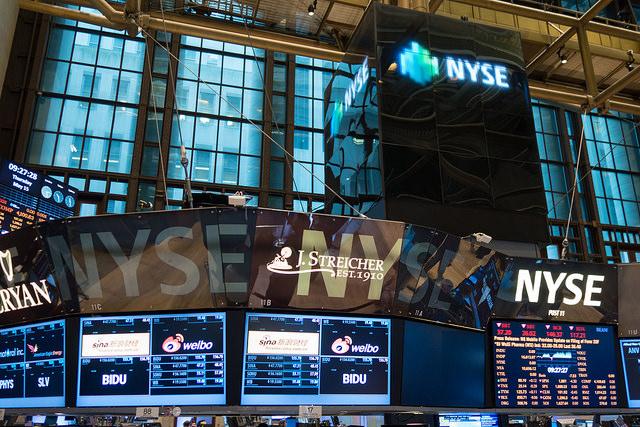Credit: Flickr user Scott Beale
Donald Trump’s stance on the economy
Republican nominee Donald Trump’s economic positions resonate with voters who support slashing taxes for both families and corporations, prioritizing the creation of jobs, producing better trade deals while preventing poor ones, revising the business relationships between the United States and foreign countries, and reducing economical regulations.
Trump’s official campaign website states that he intends to reduce taxes “across the board.” He plans to rework the current seven-bracket income tax rate structure by implementing a three-bracket system in its place. Trump’s website specifies his proposed tax rate plan for married joint filers, which are couples who record their income and deductions on the same return. Trump states that his proposed tax rates for single filers are one half of the proposed married joint filer amounts.
Trump proposes a 12 percent tax rate on joint filers with an income under $75,000, a 25 percent tax rate for incomes between $75,000 and $225,000 and a 33 percent tax rate for incomes over $225,000. Trump’s new plan would mainly cut taxes for two demographics: married joint filers who record an income between $150,000 and $225,000 and those who record an income exceeding $413,350. Most other demographics would remain relatively unchanged.
While musing over a run for the presidency in 1999, Trump suggested imposing a one-time net worth tax of 14.25 percent on people who have a net worth of over $10 million, or the “super-wealthy.” This would allegedly generate enough money to completely eliminate the national debt, which was $5.7 trillion at the time. Trump claimed that the elimination of the national debt would allow a subsequent decrease in taxes for middle-class families and bolster the trust fund for Social Security programs. These proposals were some of what Democratic nominee Hillary Clinton called “trumped-up trickle-down economics” in the first presidential debate. Over the course of his current presidential campaign, Trump has not indicated that he intends to bring his 14.25 percent tax plan to fruition.
A key component of “trickle-down economics” that Trump has supported is investing in the upper class.
“The wealthy are going to create tremendous jobs. They’re going to expand their companies. It’s a great thing for the middle class. It’s a great thing for companies to expand,” Trump said in the first presidential debate. Trump intends to reduce the corporate tax rate from 35 percent to 15 percent. This decrease would be able to be utilized by both large companies and small businesses.
Trump claims that his tax plan alone will grow the economy and create nearly two million jobs.
Trump believes that managing the American economy is “half the job” and he aims to build a “dynamic, booming economy.” Trump intends for the United States GDP to grow by an average of 3.5 percent per year, which he predicts would create 25 million new jobs over the next ten years.
Trump claims that he is qualified to oversee the economy because of his experience as a businessman and CEO of the Trump Organization. He claims that he has created tens of thousands of jobs and a “great company.” He asserts that his company is one that he is “very proud of.”
One way Trump has proposed to boost the economy is through improving trade deals. “[He will] negotiate fair trade deals that create American jobs, increase American wages and reduce America’s trade deficit,” Trump’s campaign website states.
Trump has repeatedly attacked the trade deal known as the North American Free Trade Agreement, or NAFTA. He believes NAFTA has been a “disaster,” it is “defective,” and is “certainly the worst trade deal ever signed in this country.”
“NAFTA was one of the worst things that ever happened to the manufacturing industry. You go to New England, you go to Ohio, Pennsylvania, you go anywhere you want, and you will see devastation where manufacture is down 30, 40, sometimes 50 percent,” Trump said in the first presidential debate.
Another trade deal that Trump has expressed dissent for is the Trans-Pacific Partnership, or the TPP. He asserts that it is a “close second” to NAFTA as the “worst trade deal ever.” Currently, the TPP is pending ratification, and Trump intends to withdraw the United States from the deal. Trump claims it will “lead to nothing but trouble” and it is designed for “China to come in through the back door and totally take advantage of everyone.”
Trump argues that China has beaten the United States when it comes to trade. He suggests a 45 percent tariff on foreign goods; however, he claims that it is not a tax, rather a threat.
“It will be a tax if they don’t behave. We talk about free trade. It’s not tree free trade; it’s stupid trade. China dumps everything that they have over here. No tax, no anything. We can’t get into China,” Trump said in a GOP primary debate. “The best manufacturers, when they get in, they have to pay a tremendous tax. The 45 percent is a threat that if they don’t behave, we will tax you.”
Trump intends to repatriate, or take back, jobs that “China has been stealing.” He claims that China’s wages have been increasing and that they “lack certain natural resources that [the United States] has in abundance.” Trump argues that if the United States government were to “exploit” these two “facts,” then they could start the process in convincing manufacturing companies to return home to America.
Trump has detailed a seven-point plan regarding his policies about regulations. This includes eliminating a list of all “unnecessary” regulations that “kill jobs,” immediately canceling all “illegal and overreaching executive orders” and decreasing the size of our “already bloated” government through a “thorough agency review.”
